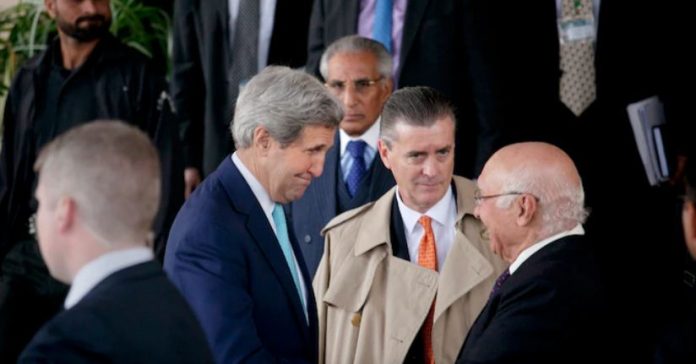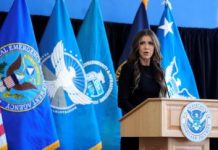When Richard G. Olson Jr. retired from the State Department in 2016, he was lauded by colleagues for an illustrious, 34-year career that included high-profile postings as the U.S. ambassador to Pakistan and the United Arab Emirates, as well as risky assignments in Iraq and Afghanistan. “Rick is quite simply one of our most distinguished diplomats,” then-Secretary of State John F. Kerry effused in a statement.
Sign up for Fact Checker, our weekly review of what’s true, false or in-between in politics.
But in the years since, Olson has come under federal investigation for a pattern of conduct atypical of the upright, protocol-observant world of international diplomacy.
Previously undisclosed records filed in court reveal that the State Department’s inspector general investigated Olson for failing to report a $60,000 gift of diamond jewelry to his mother-in-law from the emir of Dubai. As part of a broader investigation, the FBI also questioned him about his extramarital affair with a journalist working in Pakistan while he was serving as the U.S. ambassador in Islamabad, according to the documents.
The FBI learned that Olson had arranged for a Pakistani American businessman — who is now serving a 12-year federal prison sentence for illegal campaign donations and tax crimes — to pay $25,000 in tuition bills that enabled the ambassador’s girlfriend to move to New York and attend the Columbia University Graduate School of Journalism.
Records show that Olson led a complicated love life that could have left him vulnerable to blackmail. While stationed in Pakistan from 2012 to 2015, he dated multiple women even though he was married to another U.S. diplomat, who was serving at the time as the ambassador to Libya, court documents filed by his attorneys show. Olson told the FBI that he had confided in the CIA’s Islamabad station chief about his dating habits, but court records indicate that he did not report his liaisons to U.S. diplomatic security officials in accordance with State Department counterintelligence rules.
Olson, 63, is scheduled to be sentenced in U.S. District Court in Washington on Tuesday after pleading guilty last year to two misdemeanors. On the first charge, Olson admitted that when he was the ambassador to Pakistan he failed to disclose that he received an $18,000 first-class ticket to fly to London for a job interview with a Persian Gulf investment firm. On the second charge, he acknowledged that he illicitly lobbied U.S. officials on behalf of the government of Qatar in 2017, violating a federal “cooling-off” law that prohibited him from doing so for a year after his retirement from the State Department.
He was not charged with wrongdoing related to the diamonds or his girlfriend’s tuition, but the Justice Department has argued in connection with his sentencing that the episodes show a pattern of unethical behavior. In court filings, prosecutors called the emir’s jewelry “an exorbitant and obviously inappropriate gift” and accused Olson of lying to avoid accountability.
After being nominated as ambassador to Pakistan, Olson testifies at his confirmation hearing in the Senate Foreign Relations Committee in July 2012. (Win McNamee/Getty Images)
Under federal sentencing guidelines, Olson could receive up to six months in prison, though his attorneys have said he should not have to serve any time behind bars. “His career and service to his country has been nothing but honorable,” J. Michael Hannon, one of his lawyers, wrote in a memo to the court, arguing that his client had been unfairly targeted by overzealous prosecutors. Hannon declined to be interviewed for the record and did not respond to a list of written questions.
In recent years, the Justice Department has stepped up its enforcement of foreign-influence laws. Members of Congress have also sought to clamp down on the secretive practice of retired U.S. military personnel working as consultants or contractors for foreign powers.
Olson’s legal and romantic problems began after he reported to Islamabad as the U.S. ambassador in 2012. U.S.-Pakistani relations were in tatters because of the daring U.S. military raid on the country a year earlier to kill al-Qaeda founder Osama bin Laden. Pakistan had also shut down U.S. ground supply routes for the war in Afghanistan in retaliation for a NATO airstrike that killed two dozen Pakistani soldiers.
While Olson’s primary task was to soothe tensions with Pakistan’s powerful military and spy chiefs, he also began seeing Muna Habib, a young television reporter working in the country, court records show. They dated for two years but broke up in late 2014 after Habib, who is a British citizen, discovered that the ambassador had been cheating on both her and his wife, Olson’s lawyers acknowledged in court documents. “Ms. Habib believed that they were dating exclusively, while Amb. Olson was not under that same impression,” the lawyers wrote.
They resumed contact a few months later. Habib was admitted to the Columbia University Graduate School of Journalism in 2015 but couldn’t afford the $93,000 she needed to attend. Olson agreed to help by introducing her to Imaad Zuberi, a Pakistani American dealmaker with high-level business and political contacts in Pakistan, China and the Middle East, according to court records.
Zuberi had never heard of Habib before, the records show, but within days he offered to pay $25,000 to offset her tuition expenses and arrange a $50,000 loan. Records show that he sent a $20,000 check to Columbia University and $5,000 to Habib but never made good on his promise of a loan. Zuberi was sentenced in 2021 to a 12-year prison term in a separate case after he pleaded guilty to tax evasion, campaign finance violations and other charges. An attorney for Zuberi did not respond to a request for comment.
In court filings, Olson’s attorneys said that he “merely made an introduction, a very common practice for a diplomat” and that there was nothing improper about the tuition payment because he was not dating Habib at that point.
But emails submitted to the court indicate that the ambassador and the journalist still had feelings for each other.
“Our break up has been one of the most difficult periods of my life,” Habib wrote on June 16, 2015, while the tuition deal was being sorted out. “I knew how you had behaved in all your previous relationships and I continued to see you. It didn’t matter to me because of how you made me feel loved, special, something that I had never experienced before.”
“Glad we’re still friends,” Olson replied. “I care deeply about you too.”
In a brief phone interview, Habib dismissed questions about her relationship with Olson as “salacious gossip,” adding, “I’m sick and tired of it.” She asked for a list of questions in writing but did not respond to them.
Olson reported his relationship with Habib to the CIA’s station chief at the U.S. Embassy in Islamabad but “did not report his contact with Habib in any other way,” according to notes from a 2019 FBI interview with the ambassador. According to the State Department’s Foreign Affairs Manual, diplomats with high-level security clearances are required to report any “intimate/sexual contact” with foreign citizens to diplomatic security officials for counterintelligence purposes.
Olson’s attorney did not respond to questions from The Washington Post about whether he had properly reported his relationship with Habib or how many other women he dated while in Pakistan. Jennifer McKewan, a State Department spokesperson, declined to comment on Olson’s case.
While Olson was ambassador to Pakistan, he was also fending off a State Department investigation about a different matter.
In 2014, someone tipped off the State Department’s inspector general that 11 years earlier, while Olson was serving as the head of the U.S. Consulate in Dubai, the emir of the Persian Gulf city-state had delivered a velvet box to his office, records show. Inside were four diamonds set in white gold — a pendant, a ring and a set of earrings — that federal officials later valued at $60,000, according to court documents. They do not name the emir; Dubai has had two different two emirs since 2003.
Under the standards of the Foreign Gifts and Decoration Act in effect at the time, U.S. officials were required to report gifts with worth more than $285 and could not keep them unless they reimbursed the federal government for the fair-market value.
Olson did neither. He told State Department investigators that the emir had given the diamonds not to him but to his mother-in-law, who was living with him in Dubai, according to correspondence from State Department officials and other documents submitted to the court by his lawyers. He said the emir wanted to express gratitude to his mother-in-law for coming to Dubai to help care for the ambassador’s two children.
Olson’s then-wife, Deborah Jones, was based in Washington at the time as a senior State Department official, overseeing the Office of Arabian Peninsula Affairs. The department also placed Jones under investigation because she supervised U.S. policy in the region and had formerly served as the deputy chief of mission in the United Arab Emirates, records show.
Former U.S. ambassador Deborah Jones testifies at a Senate Foreign Relations Committee hearing on Libya in 2017. (Chip Somodevilla/Getty Images)
In an interview with The Post, Jones defended the jewels as a legitimate gift to her mother and said neither she nor Olson did anything wrong by failing to report it. She recalled that State Department officials confronted her about the diamonds while she was serving as ambassador to Libya in 2014, and called the investigation “very offensive” and “very unpleasant.” She said her mother considered the diamonds to be a genuine personal gift from the emir, adding, “I find it incredibly sexist that I was somehow pulled into this by virtue of being her daughter.”
The State Department closed the investigation without taking personnel action against Jones or Olson after they successfully argued that Jones’s mother was not their dependent for tax purposes and therefore not covered by the gift rules, records show. Even so, in a September 2016 letter, State Department lawyers asked the couple to voluntarily relinquish the diamonds, saying it was “extremely disappointing that you were not sufficiently concerned with the gift to seek guidance from the ethics office.”
In a November 2016 letter, Olson told the State Department that he couldn’t force his mother-in-law to hand over the diamonds, “which I think she would regard as robbery.” Jones told The Post that she also tried but failed to persuade her mother to part with the jewels. “I said, ‘Mom, look, these are really causing a problem, and they’re causing a problem to me.’ But she said they were hers.”
Jones said that her mother died in December and that she’s not sure what happened to the diamonds. She and Olson filed for divorce in 2018, though she said they have a cordial relationship.
Around the same time, Olson rekindled his romance with Habib, who by then had completed her studies at Columbia University’s journalism school, according to documents filed by his attorneys. They married in June 2019 and now live in New Mexico.
Courtesy Washington Post

















